Barbenheimer is a certifiable cultural phenomenon. The tongue-in-cheek name social media granted to Greta Gerwig’s Barbie and Christopher Nolan’s Oppenheimer when people first noticed they were releasing on the same day has metastasized into a kind of participatory cultural rite, with jokesters creating fake posters and real merch for the release, not to mention endless memes.
Tens of thousands of people have already certifiably bought back-to-back tickets for their own Barbie/Oppenheimer double features. But there’s been a weird sort of angst about the double feature online, with people asking social media outlets — or, according to Google Trends, asking search engines — what the proper Barbenheimer watch order is. Which should come first, the father of the atomic bomb, or the mother of all fashion-doll trends?
Plenty of the people responding to the “Which order should I watch Barbenheimer in?” question online are exasperated that it’s even a question, but their “obvious answers” depend on their personal tastes. Your mileage may vary as well. Fortunately, there’s an easy way to navigate this. The important thing about Barbenheimer isn’t the watch order. It’s giving both movies enough space to breathe, and giving yourself a break between them.
:no_upscale()/cdn.vox-cdn.com/uploads/chorus_asset/file/24802553/1546723868.jpg)
Look, anybody can do the basic math. Oppenheimer is a heavy, complicated historical film about scientific progress, mass destruction, and the inevitability that someone is standing by to weaponize every new step we take toward understanding the universe we live in. Barbie is a cheeky satire that examines the conflicting cultural feelings we have about the world’s most famous doll brand, and what she represents. They go together surprisingly well, it turns out — they both explore culpability, whether one person can make a difference, and the heavy impossibility of fighting back against a rigged system. (They also both have a pretty clear throughline of “Wow, men suck.”)
With that in mind, you can decide for yourself whether you want to end your Barbenheimer on a downer note or an upbeat one, whether you want to end your double feature on a perky note or a weighty one. Some people will want to wrap up with the happy ending and the note of hope. Others will want to end with the more “serious” movie. Also, Oppenheimer is three hours long — some people might not want to do that one first, because of the risk that they won’t be up for Barbie afterward. This double feature is a butt-numbing commitment.
So there is no “definitive” watch order. But there is every reason to curate yourself a pretty significant break between movies. Go get dinner. Sit and talk through whichever one you saw first with whoever you went with, or let the first movie percolate in your head if you went alone.
Because in spite of the impression that Oppenheimer is a serious grown-up movie and Barbie is cheery comedy fluff, both of these movies are a lot of movie. They’re both deliberately packed with discussion topics, and they’re coming from filmmakers who clearly want viewers to think about and absorb their ideas. Oppenheimer is asking big questions about humanity’s capacity for self-destruction, and about the ways the urges to create, to understand, and to destroy are all connected. Barbie is asking surprisingly similar big questions about how societies are structured and why humanity is so bent on making them all dysfunctional and dystopic. These are both discussion-worthy movies that weren’t made with the idea of people running out of them and straight into another movie.
And both of them take some digestion for reasons that don’t even relate to their big moral questions. They’re each designed to stun audiences, again in surprisingly similar ways. Gerwig’s movie is a gag-per-second roller coaster, an incredibly dense and fast-moving story peppered with multitasking-in-mind banter layered over visual gags layered over important plot movement.
Nolan’s movie, meanwhile, leaps back and forth in time, layering eras together to find a path through a story where the past, present, and future all affect each other. His cast is huge, and their identities are important. Introductions blur by, and a man who gets one quick scene in the first half-hour may resurface two hours later, with significant impact and minimal explanation. Both of these movies are a lot to take in, in the best way — and they both benefit from a little breathing room afterward.
So ignore the pundits and the social-media scolds, and curate your own adventure through Barbenheimer. There is no right or wrong answer here, there’s just whatever’s going to give you the most filmgoing pleasure. But make sure part of that curation is giving yourself a break between movies. They’re both better that way, and the larger Barbenheimer experience is, too.






